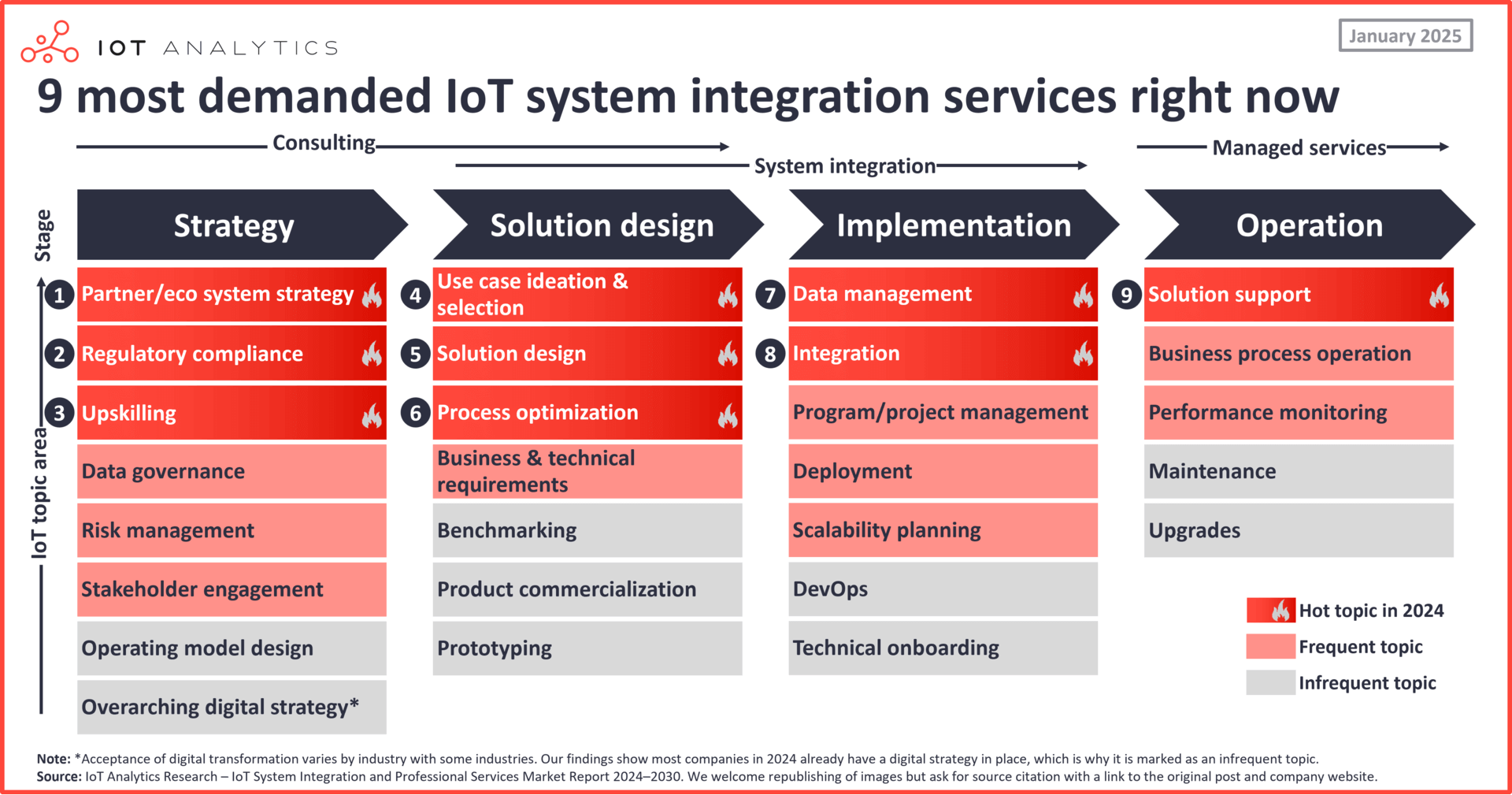
In short
- As IoT technology matures and becomes more engrained with other technologies like AI, IoT integrators are moving from strategic and siloed IoT integration services to more end-to-end project support and holistic integrations, according to IoT Analytics’ IoT System Integration and Professional Services Market Report 2024–2030 (published December 2024).
- 5 companies held 20% of the ~$56 billion IoT professional services market in 2024.
- IoT Analytics presents the 9 most in-demand IoT system integration services that are driving the business of system integrator/consulting firms.
Why it matters
- For IoT adopters: The focus of IoT system integrators is changing as they work to meet the IoT maturity level of their clients. Adopters should understand what services are available and which are in demand by their peers to maintain competitive awareness.
- For IoT system integrators: With companies progressing in IoT maturity, IoT system integrators must assess their clients’ growing and more complex needs to remain competitive.
IoT system integrator and professional services market snapshot
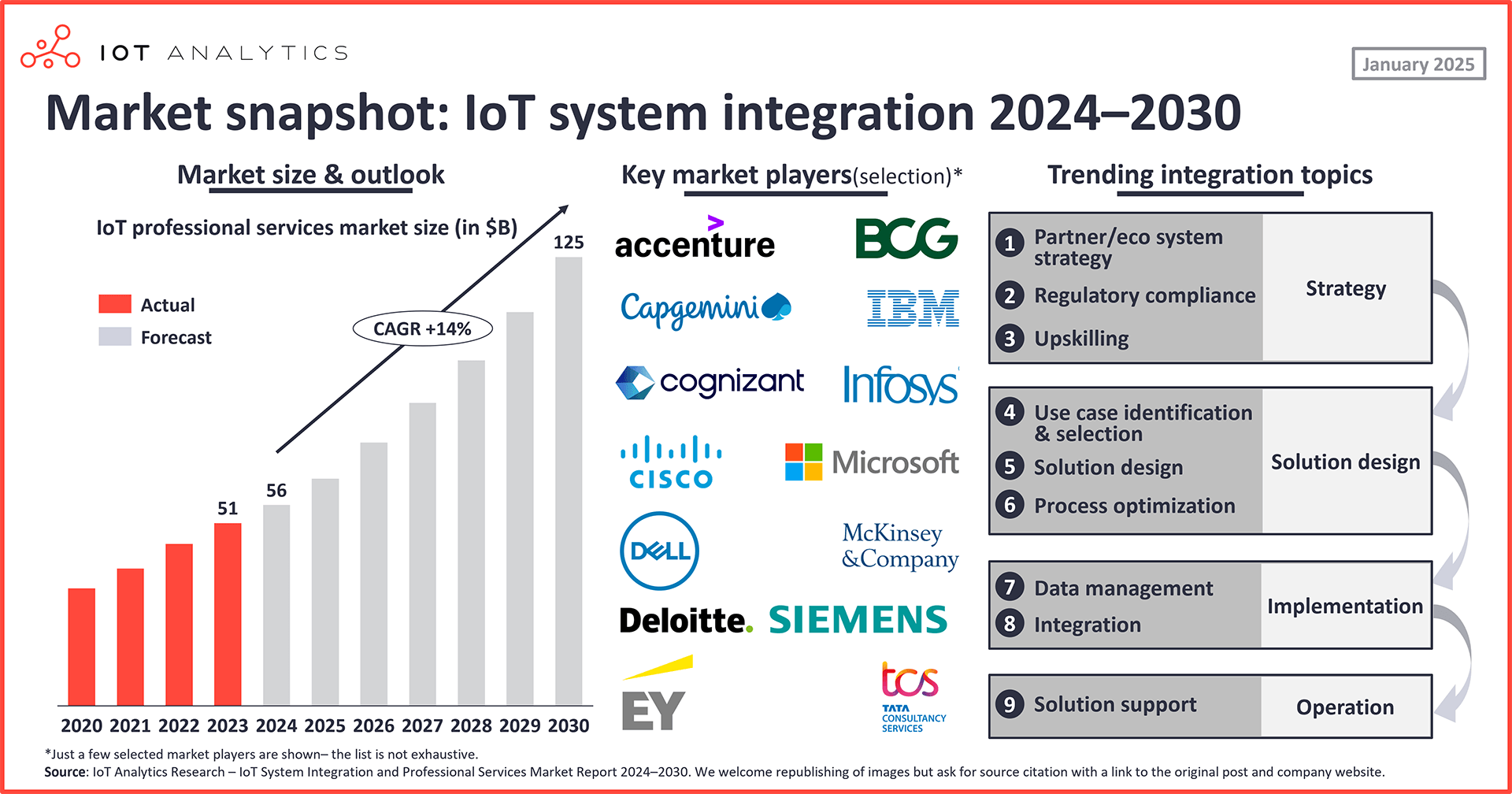
The global IoT professional services market has grown 46% in 3 years. In 2024, the market for IoT system integration and professional services was approximately $56 billion, up from $38.4 billion in 2021 when IoT Analytics last published research on this market. The market is comprised of thousands of companies, including the largest professional services companies in the world and some boutique companies that focus specifically on IoT. The top 5 professional service vendors, which make up 20% of the market, are Ireland-based Accenture, UK-based Deloitte, India-based Tata Consultancy Services (TCS), India-based Infosys, and France-based Capgemini.
Some IoT integrators struggle, but the majority continues to expand. Several IoT-focused system integrators have recently faced insolvency, including Tresmo, Vodafone-owned Grandcentrix (both German IoT integrators), and Control Systems Design & Integration, Inc. (a US-based industrial automation services provider). These instances highlight the financial challenges some companies encounter in the competitive IoT integration market. However, these examples are outliers, as many other system integrators continue to grow and report strong numbers, driven by increasing demand for IoT solutions in industries such as manufacturing, energy, and transportation.
The insights from this article are based on
IoT System Integration and Professional Services Market Report 2024–2030
A 188-page report examining the IoT professional services space, particularly IoT system integration. Includes market size and outlook, competitive landscape, case studies, customer adoption considerations, key trends, and more.
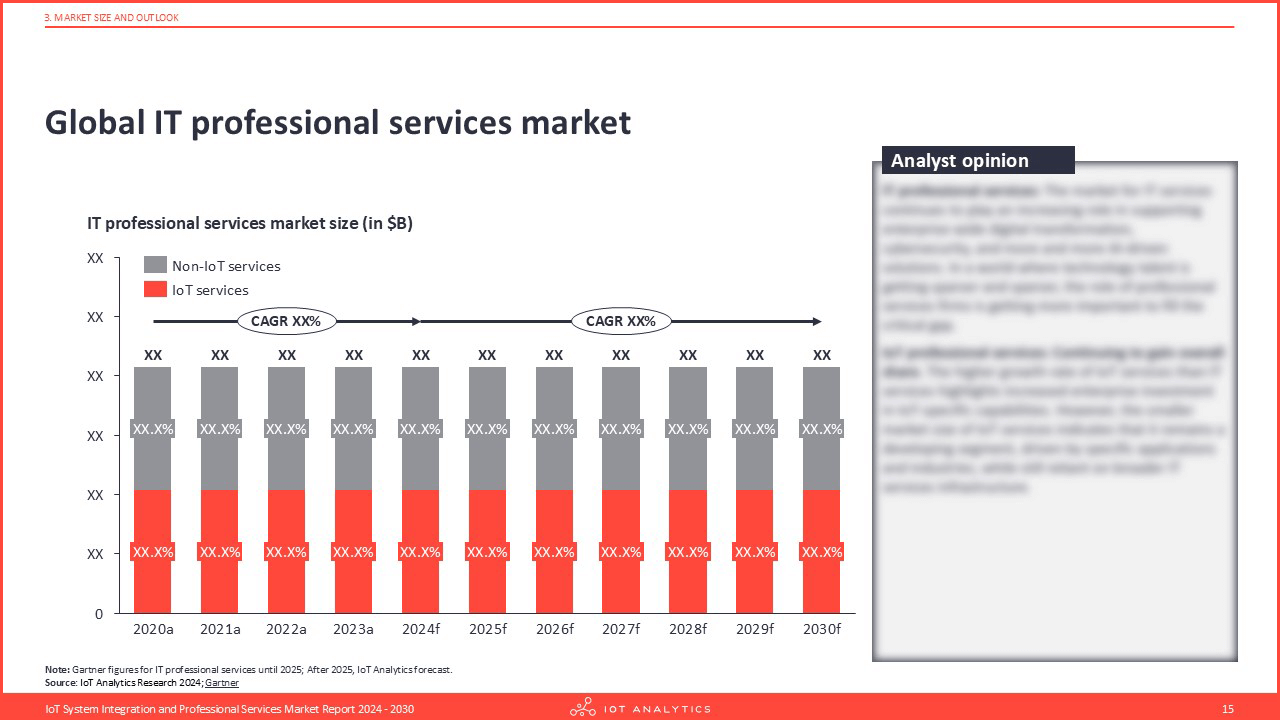
Download a sample to learn more about the report structure, select definitions, select market data, additional data points, and trends.
Already a subscriber? View your reports here →
The shifting focus of the IoT integrator
IoT services shift from strategy to implementation. Since IoT Analytics’ 2021 report on IoT integration and professional services, the general focus of IoT services that companies have requested has moved from major strategy topics, such as formulating holistic digital and IoT strategies, toward more ground-level solution design and individual solution implementation. Today, most clients have plans and strategies in place and are acting on those strategies they formulated 3-5 years ago.
“Our IoT customers’ priorities have shifted over time. 5 years ago, many focused on developing a general IoT strategy. Today, while some revisit earlier decisions, most seek support with designing and implementing specific use cases and solutions.”
Vincent Ohana, managing director at Concept Reply
IoT system integrators remain integral to IoT projects amid skill shortages. In 2023, nearly 50% of IoT projects involved custom-built solutions, many of which are built by system integrators, according to IoT Analytics research. However, companies implementing IoT projects in recent years have faced a shortage of IoT skills involving aspects of the IoT tech stack—e.g., data management and storage, software development, and the overall ecosystem—leaving them without the necessary internal expertise to complete their initiatives. To fill these skill gaps, companies regularly work with IoT systems integrators and other professional service providers who are hired to manage and implement the projects and get them launched.
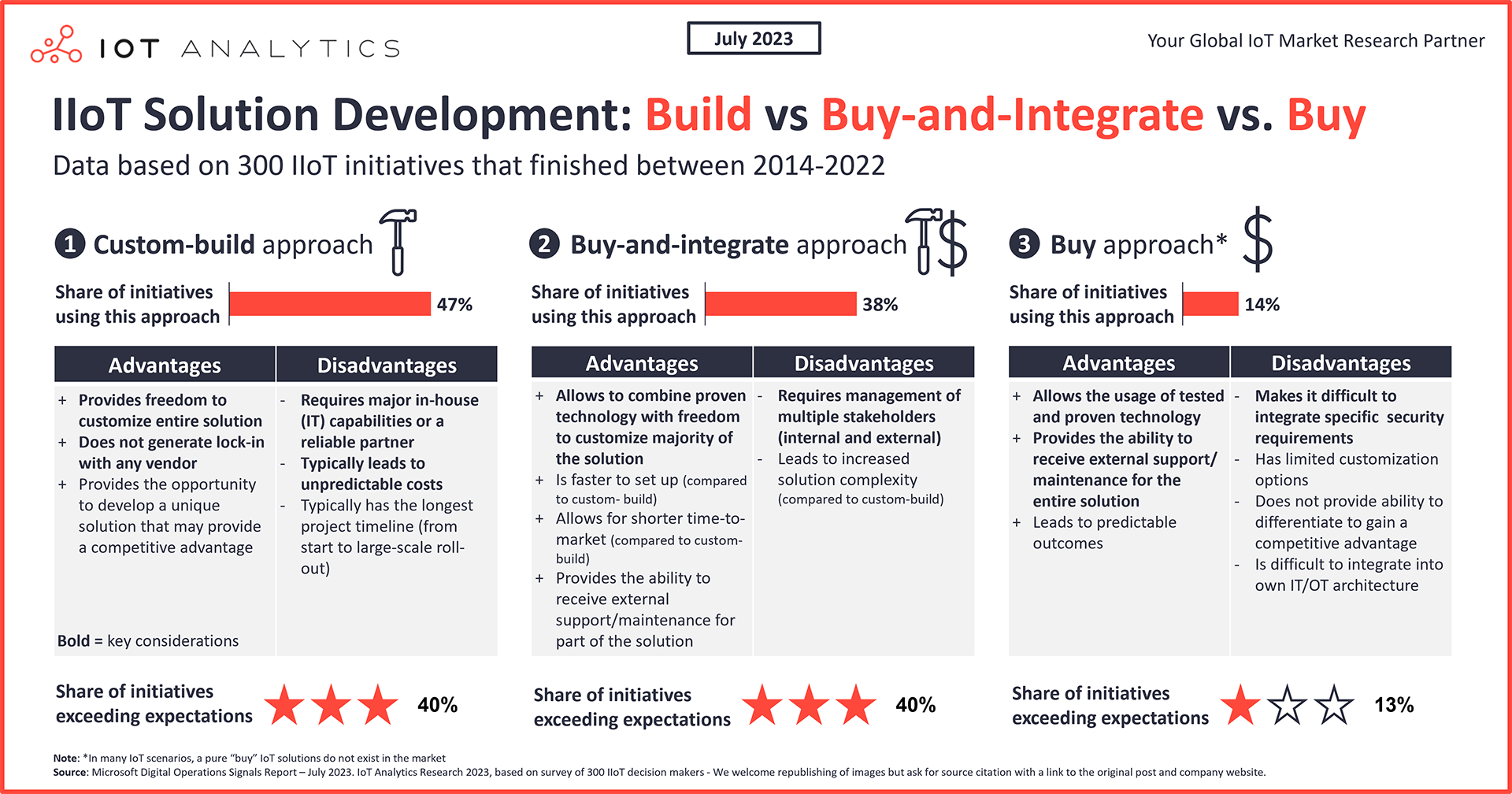
Progressing IoT maturity is changing some of the integration topics. Compared to other technology areas, the deployment of IoT technology has become particularly complex. As shown below, many companies are progressing in their IoT maturity, going from early network-enabled assets and connectivity stages (stages 1 and 2, respectively) to building new, self-centric applications capable of utilizing IoT data and, at the same time, connecting to existing software applications (stage 4). Seemingly around the corner is stage 5, when companies integrate AI into their solutions and applications to enable AI-driven use cases such as predictive maintenance and process automation.
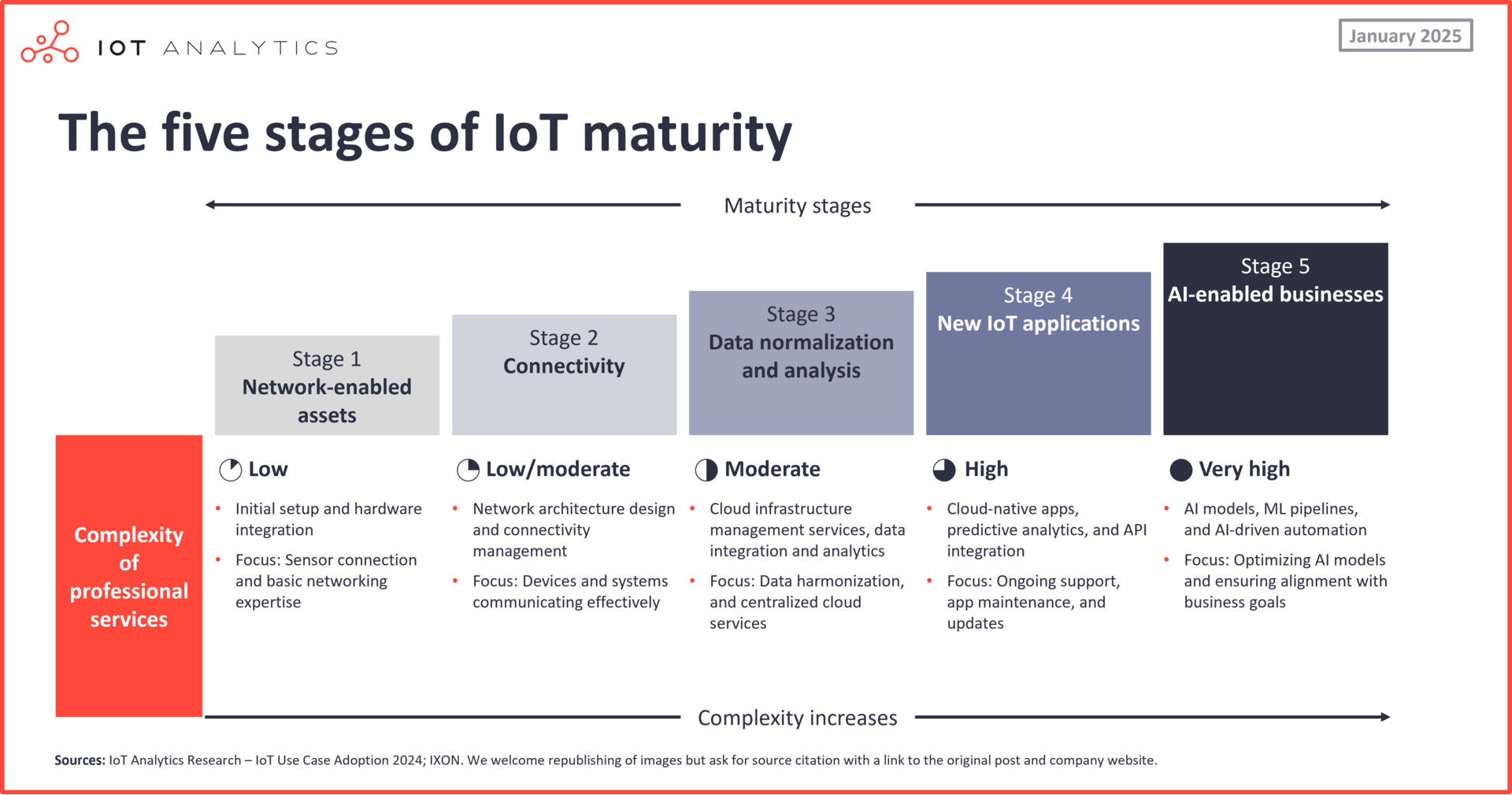
In short, the focus of the IoT system integrator is changing. More mature IoT projects require a broader range of expertise to connect a large number of devices with potentially various applications. This means larger teams with very different skill sets that have historically been separated, including secure embedded design and engineering, connectivity management, cloud and IT architecture, data science, and application development. The importance of an IoT system integrator supplying experts and managers with these skills and helping companies build and scale IoT projects has never been greater.
9 IoT topic areas are in high demand. Based on interviews with numerous professionals in the IoT domain, the IoT Analytics team has created a heatmap of IoT topic areas, 9 of which are currently in high demand along the IoT system integration and professional services value chain. Most of these services have remained in high demand since 2021, when IoT Analytics identified 7. Gaining traction over the past 3+ years are partner/ecosystem strategy, regulatory compliance, and solution support, while product commercialization services have become a less in-demand service.

(Note: The heatmap is based on 10+ discussions with experts in the IoT system integration field and should only be treated as an indication due to the relatively small sample size. Hot topics are defined as those that were in greatest demand according to the IoT System Integration and Professional Services Market Report 2024–2030.)
The 9 most demanded IoT system integration services
1. Partner/ecosystem strategy
Partner and ecosystem strategy experts help companies future-proof their IoT initiatives. Whether looking to custom-build their own IoT stack or partner with a vendor for an IoT initiative, companies face many technology and vendor options. Companies also must consider how to best future-proof their ecosystem, and without internal IoT expertise, looking ahead can be daunting.
Companies initiating IoT projects are turning to consultants who specialize in IoT partner and vendor selection as well as in ecosystem strategy. These consultants work with companies to re-visit their near-, mid-, and long-term technology vision. These specialists often have knowledge about various vendor offerings, including how interoperable their solutions are.
Example 1: Global accounting and technology advisory firm KPMG offers Technology Strategy and Selection services, citing an objective, technology-agnostic approach to best satisfy their clients’ needs.
Example 2: Concept Reply offers IoT Platform Assessment services. With this service, the company helps customers revisit existing IoT platforms and related architecture decisions made in the past and evaluates the ability to support upcoming use case priorities, shifting requirements, and compliance with security and regulations.
“We often engage in vendor selection projects where we step in with our independent consulting service line. Our role is to assess the business and technology challenges and create a technology option space for our customers to resolve those challenges. It is important to note that we also have non-vendor-agnostic units (e.g., for Microsoft, ServiceNow, AWS) but these groups naturally have some biases due to their specific focus areas.”
Business analyst at a professional services company during an IoT Analytics interview (2024)
2. Regulatory compliance
Recent regulations drive the need for regulatory compliance experts. In the last few years, a fair number of data protection and sustainability-oriented regulations have been enacted worldwide—at the regional, national, and even state or province level—each including penalties for non-compliance. Such regulations add a great deal of complexity to IoT projects: interconnected systems generate large volumes of data that need protection, and sustainability regulations have created the need for companies to collect and report various data points related to energy use and their carbon footprints (an area where IoT can actually help, e.g., via sensors).
Further complicating matters, though a country may not be headquartered or have major branches in a territory with a given regulation, the regulation may still impact its operations if it does business there, creating a great need to track all applicable regulations and comply. Examples of regulations with broad impact include:
- The EU Data Act – Establishes rules for access to and sharing data generated by IoT products placed on the EU’s market and requires compliance by September 2025
- The EU Corporate Sustainability Reporting Directive (CSRD) – Requires both large companies based in the EU or non-EU companies that generate over €150 million in EU-related revenue to report information related to the risks and opportunities arising from environmental and other issues and the impact of their activities related to those issues
- The US state of California’s Climate Corporate Data Accountability Act – Requires business entities formed under the laws of any US state that does business in the state with over $1 billion in revenue (in total, not just from California) to start disclosing their greenhouse gas emissions by 2027
These challenges—and opportunities—associated with regulatory compliance are driving the increased demand for compliance experts who can navigate the complex regulatory landscape while ensuring that IoT systems meet both legal and ethical standards.
Example 1: UK-based professional services Ernst & Young (trading as EY) offers EY Regulatory Compliance Manager, which allows clients to digitally manage compliance by identifying regulation changes, steps to be compliant, and how to monitor ongoing compliance.
Example 2: UK-based PricewaterhouseCoopers (branded as PwC) offers regulatory risk and compliance services to help its clients evaluate the impacts of new regulations on their business models and develop/implement risk-based compliance control frameworks.
“The green energy segment is also heavily influenced by new sustainability regulations, data privacy concerns, and the need for knowledgeable professionals and flexible systems.”
Global VP for technology, partner business, and software at Schneider Electric during an IoT Analytics interview (2024)
Note: IoT plans to release its Sustainability Management Platform Report 2025–2029 in Q1 2025 and a report on the impact of regulations in Q2 2025. Those interested in accessing these reports when they are released can sign up for IoT Analytics’ IoT Research Newsletter by clicking below.
3. Upskilling
New or updated technology calls for professional training and certification. When adopting IoT or even upgrading or adding to existing IoT systems, there may be a gap between the demands of the technology and the existing workforce. If preferring to keep IoT talent in-house, companies often turn to IoT change management consultants to design and coordinate training programs to equip their employees with the skills needed for the new technology.
Upskilling for IoT integration is often provided by IoT integrators to their customers through a mix of formal training, certifications, and hands-on experience, including:
Example 1: Training programs. Many integrators offer tailored workshops or coursework on IoT protocols, platforms, and integration best practices. Capgemini, for example, offers courses across numerous technology fields, either as online group courses or in-company. One such course for IoT integration is its Software Integration Foundation course, designed to teach the principles, methods, and technologies behind connected devices.
Example 2: Certifications. Several large technology providers offer credentials that validate and formally certify an integrator’s ability to implement and integrate their technology after meeting specific requirements. For example, US technology company Dell Technologies offers numerous certification courses, such as Dell Zero Trust Design for cybersecurity and several networking certifications for connectivity.
Example 3: On-the-job learning. Real-world projects and pilot deployments offer invaluable practical experience. TCS offers worker assistance and training as part of its Connected Plants & Smart Manufacturing “connected workforce” offerings. When TCS developed digital twins for Tata Chemicals Ltd.’s (TCL) carbonation boilers and towers, it offered on-site training on the implemented systems and processes.
4. Use case ideation and selection
Professional services help companies home in on the right use cases. Connecting devices and assets through IoT opens up opportunities for hundreds of use cases. But how should companies go about selecting which use case is best? Should a company prioritize predictive maintenance of its assets, real-time inventory management of its products, or energy monitoring for costs and sustainability? With limited resources and experience, the numerous opportunities can become overwhelming when deciding. This is where professional services consultants can help.
Our research shows that most IoT system integration and professional services firms have developed some form of framework (often following the design thinking philosophy) to help their clients navigate the topic of use case ideation and prioritization.
Example: US-based technology and consulting services provider IBM has a collaborative framework called IBM Garage, which helps customers identify business opportunities, use cases, and required technology capabilities (as well as allows stakeholders to co-create, prototype, and scale their solutions).
5. Solution design
IoT system design complexities drive need for IoT integrators and professional services. As mentioned, nearly 50% of IoT projects involve custom-built solutions, where professional services play an essential role as the project designers and enablers. Designing an IoT solution often requires experienced project management (setting targets and the end goal) and technology expertise (the know-how to make it happen)—skillsets that IoT professional services and system integration firms have ready.
Example: Germany-based digital transformation services company Siemens Advanta (a strategic business unit of Siemens) offers Solutions Development, services tailored for digital product development and system integration. Further, Siemens Advanta offers Solutions Prototyping, which allows companies to plan, design, test, and evaluate their initiatives (be it a physical product, software, or a process/service).
6. Process optimization
IoT system integrators help companies identify operational areas for IoT-driven improvement. Companies using IoT solutions in their operations or manufacturing setup often ask IoT system integrators to analyze and improve their processes. In turn, key services and solutions that professional IoT services companies focus on include predictive maintenance, real-time monitoring, digital twin integration, and process automation to enhance industrial productivity.
Example: Deloitte has built five showcase smart factories demonstrating advanced manufacturing technologies in Wichita, Düsseldorf, Kyoto, Tokyo, and Montreal. The factories provide Deloitte’s clients with hands-on environments in which they can think through their manufacturing process optimization challenges and explore IoT solutions to enhance their efficiency and productivity.
“A lot of companies focus on IoT for process optimization with the ultimate goal to save costs. IoT in the last years has become much less about generating new revenue and more about how much money can be saved.”
Vincent Ohana, managing director at Concept Reply
7. Data management
Professional services companies are helping companies prepare for AI through data management.
Many CEOs are advocating for their organizations to adopt AI. In recent quarters, C-suite discussions about AI have moved from the novelty of generative AI models and chatbots to how they can leverage AI to better their operations. However, there is no AI strategy without a data strategy, and this shift toward AI integration is prompting companies to rethink (or even develop) their IoT data management strategies. Professional services companies are offering enterprise data management and analytics solutions to help companies assess and/or develop their data management strategies for AI.
Example: Infosys. The company offers general Data for Digital services aimed at helping its clients manage various business data and keeping it consistent across different systems. Additionally, Infosys offers Data Analytics and AI services, which help enterprises manage and govern company data and then prepare for and adopt AI solutions.
8. Integration
Companies still seek traditional integration services. Classical system integration continues to play an important role in 2024. Key themes include:
- Integrating and migrating workloads into the cloud (including hybrid and multi-cloud architectures)
- Connecting disparate applications and platforms (e.g., IoT platforms and enterprise resource planning)
- Harmonizing the edge-to-cloud setup
Complex integration solutions require new professional service expertise. Systems are becoming ever more interconnected, and offering traditional end-to-end integration capabilities has become crucial for system integrators that seek to satisfy customer needs. However, it is challenging for IoT integration firms to scale end-to-end digital capabilities organically. Partnerships, collaboration, and strategic acquisitions play an important role.
That is why the IoT system integration vendor landscape is witnessing continued merger and acquisition activity.
Example: In April 2024, Capgemini acquired the Digital Twin Professional Services arm of Unity, a US-based game and interactive experiences software company. The acquisition enables Capgemini to embed real-time 3D (RT3D) capabilities into its business transformation services, aiming to help clients better visualize, understand, and interact with physical systems through digital twins.
9. Solution support
Solution support ensures IoT scalability and performance. Solution support services play a critical role in ensuring the long-term success of IoT implementations by addressing lifecycle management and post-deployment challenges and optimizing system performance—all in demand by companies adopting IoT initiatives. These services support IoT systems’ continuous operation and scalability by integrating updates and patches as technologies evolve.
“[A] lot of the head count growth […] is the additions to our managed services team during—over the course of the past year. […] This is an area where we continue to see excellent growth potential business.”
John Kelly, CFO at Huron Consulting (Q1 2024 earnings call on April 30, 2024)
Analyst opinion: Looking ahead at stage 5
AI-driven IoT transformation reshapes enterprise data strategies. As companies move to stage 5 of IoT maturity (becoming AI-enabled businesses), their needs shift from basic operational enhancements to fully autonomous, AI-driven systems. This will likely lead to AI integration into IoT operations, not just at a technological level but also at an operational one, requiring a rethinking of how data is used across enterprises.
Advancement hinges on overcoming data and scalability challenges. Achieving this level, however, comes with challenges, particularly around data harmonization, scalability, and cross-system interoperability. Just like with previous technology innovations, organizations will increasingly depend on and demand IoT system integrators to manage the complexities around data management, deploy AI models at scale, ensure IT-OT integration, and maintain system reliability.
IoT system integrators must adapt to sustain growth. IoT adoption, in general, has had its challenges in recent years, with several tech companies exiting (e.g., Google’s IoT Core). Despite this, the analysis in the IoT System Integration and Professional Services Market Report 2024–2030 shows high, profitable growth for the IoT system integrator market in the years to come. The shuttering of some IoT-focused integrators like grandcentrix shows that IoT system integrators are not immune to failure. Companies must follow customer trends and needs, such as the 9 most in-demand services above. Only those who adapt their focus accordingly, as well as align with the right technology partners, will continue succeeding in this market.
Disclosure
Companies mentioned in this article—along with their products—are used as examples to showcase market developments. No company paid or received preferential treatment in this article, and it is at the discretion of the analyst to select which examples are used. IoT Analytics makes efforts to vary the companies and products mentioned to help shine attention to the numerous IoT and related technology market players.
It is worth noting that IoT Analytics may have commercial relationships with some companies mentioned in its articles, as some companies license IoT Analytics market research. However, for confidentiality, IoT Analytics cannot disclose individual relationships. Please contact compliance@iot-analytics.com for any questions or concerns on this front.
More information and further reading
Are you interested in learning more about IoT system integration?
IoT System Integration and Professional Services Market Report 2024–2030
A 188-page report examining the IoT professional services space, particularly IoT system integration. Includes market size and outlook, competitive landscape, case studies, customer adoption considerations, key trends, and more.
Download the sample to learn more about the report structure, select definitions, select data, additional data points, trends, and more.
Already a subscriber? View your reports here →
Related publications
You may also be interested in the following reports:
- IoT Commercialization & Business Model Adoption Report 2024
- IoT Enterprise Projects Adoption Report 2024
- IoT Use Case Adoption Report 2024
- IoT Software Adoption Report 2023
Related articles
You may also be interested in the following articles:
- How to create a successful IoT business model—Insights from successful OEMs
- The top 10 IoT use cases
- The leading IoT software companies 2023
Further information
IoT Analytics continuously monitors emerging trends in the IoT market, providing enterprise clients with valuable insights through our subscription services. Stay informed on the latest industry developments by subscribing to our Newsletter and following us on LinkedIn.
For comprehensive IoT market intelligence, including full access to our premium reports, in-depth analyses, and dedicated analyst support, consider our Corporate Research Subscription


